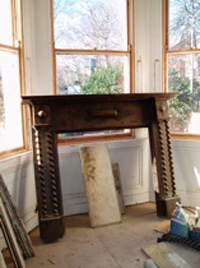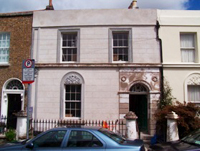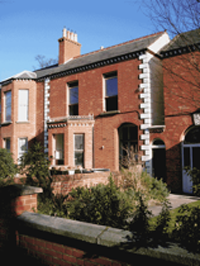Why buy a Protected Structure?
Old buildings can be expensive to heat and maintain, requiring ongoing expenditure over many years. They will not comply with modern Building Regulations. Rooms may be too big or too small for modern living arrangements. Nevertheless, people often wish to live in a house with history and character, which is impossible to reproduce. Many older buildings are fundamentally sustainable through their longevity and capability to be sensitively adapted to cater for contemporary needs.The desire to live in a Protected Structure should be considered alongside an informed, practical, approach to the inevitable costs and possible disruption of ongoing maintenance and repair.
Making Your Choice
Don't buy an old building unless you are happy to live with its particular character, quirks and indeed faults. You will have to adapt to it, rather than trying to mould it into something completely different. This includes its details as well as its overall form. If you want to make the beautiful undulating plaster walls inside the house plumb-straight, with modern plastering techniques, you will loose a huge part of the subtle detail that defines the property. Replacement doors and windows, if required must be sympathetic in their design and detail to the building's originals. Expert conservation guidance is required for this type of work as off-the-shelf replacements do not exist and joinery manufacturers require detail drawings and specification.
Post-Purchase
The more you know about your building, the more informed a client you will be, and the easier it will be to brief a Conservation Architect with your requirements or to work with a builder.
Don't start stripping out the building carelessly - what may appear to be worthless and disposable should offer clues to an experienced eye. Remember the entire building fabric is protected and you will need either Planning Permission or a Declaration.
When you have purchased, seek the professional advice of a Conservation Architect at the earliest opportunity. Great care is required when appointing a building contractor to do the actual work, and the Architect will help you to select builders to tender who have suitable skill and experience. Old, traditional materials and finishes were textured, not sharply finished, breathable not impervious. By employing the wrong builder or using the wrong materials, you can obliterate the character and charm of an old building in a short period of time.
Calculate what you can afford. Money should be spent first on the essentials; repairs to the fabric can be expensive and mundane to many but must not be ignored. When work does start, make sure that all interior features are protected thoroughly. Even the most careful and conscientious builder can accidentally damage important features.
Extending a Protected Structure
If you think you may need to extend a Protected Structure to cater for your needs, you should be aware that normal Exempted Development provisions do not apply. You will need planning permission and any application will be assessed in much greater detail than for a typical domestic extension. You will be required to demonstrate a high-quality design, which does not detract from the existing building's fabric, setting or historic significance. A detailed Conservation Report must accompany any planning application for a Protected Structure.
Current Building Regulations do not apply to a Protected Structure but they do apply to any works to alter or extend such a building. The regulations recognize that there may be areas where they are unduly restrictive and therefore inappropriate to Protected Structures. They provide for alternative approaches based on the principles contained within the Technical Guidance Documents.
When you have to extend the building or do new work in the interior, don't just imitate the existing. As RIAI Grade 1 Conservation Accredited Architects we understand the character and qualities of the old and can add our contribution, respecting the proportions and form of the building. New work that is honestly of its own time will be accepted and even encouraged by Planning Authorities if the proposal is of a very high design standard.
General Practical Guidelines
Respect changes made in the building's past and avoid guesswork, which can lead to conjectural restoration. Work with the building; don't attempt to make a simple house grandiose, or to disguise a building converted from a different use. Don't expose rubble stone construction when the building originally had lime render and don't replace soft lime render with hard and impermeable cement that won't let the building breathe. Work with what is there. After all, that was what drew you to the property initially!
In the long-term, the best advice is to do little, and often, to keep an old building in good condition. We will be adding further information to our website shortly addressing ongoing maintenance and care of Protected Structures.
Grant Assistance and Incentives
A scheme of grants is operated by County Councils and Town Councils, to assist the owner or occupier of a protected structure to undertake necessary works to secure its conservation.
The standard amount of grant is 50% of the approved cost of works, up to a maximum of €13,000. A planning authority may, at its discretion, vary this amount downwards, or, in exceptional circumstances, upwards, subject to a maximum allowable grant of 75% of the approved cost of works, or €25,000, whichever is the lesser.
Grants of Planning Approval often come with a condition to pay a "Development Contribution" to the Local Authority. This normally applies to extensions over 40 Sqm in area. The majority of Local Authorities allow an exemption or significant reduction from these payments in relation to Protected Structures.
Sustainable Energy Ireland (SEI) also offers grants, which will often be applicable when installing measures to enhance thermal performance and reduction of Carbon Dioxide emissions.
We can advise on eligibility for all available grants and make applications with the required supporting documentation.
Some Final Good Sense
An old house that best reflects its age and character, while also being comfortable and practical, will certainly prove to be the most enjoyable to live in and easily saleable in the future. Nothing is more disconcerting than a house on which too much money has been lavished to the wrong ends, and inevitably, on which a future purchaser has to spend to get rid of someone else's "improvements". It makes good sense to consider your relationship with your Protected Structure as being one of a Custodian or Steward who will eventually pass the property on as a part of the built heritage that has been not just retained but also hopefully carefully enhanced.





